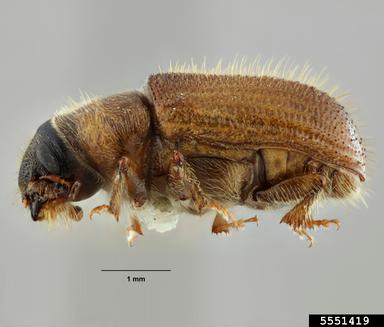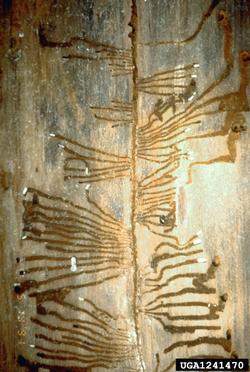Douglas-fir beetle (Dendroctonus pseudotsugae)
Trees Affected


Common: Douglas-fir
Occasional: None in California
Summary
The Douglas-fir beetle is a medium-sized (1/8” to 1/4” long) bark beetle that is capable of killing healthy, mature trees. Despite this ability, the background mortality caused by these beetles during a typical year is restricted to trees or clusters of trees that are already experiencing stress such as root disease or drought. However, if the Douglas-fir beetle has access to an abundance of downed or recently dead trees, population levels can rise enough to cause an outbreak and more widespread tree mortality. Symptoms of Douglas-fir beetle attack begin with orange boring material in bark crevices and sometimes clear pitch tubes running down the trunk from entry holes. Within a year of attack, patchy yellowing of the crown may occur, but it is also possible for crowns to turn uniformly yellow and then red a year after attack. Post-infestation and tree death, pouch fungus (Cryptoporus volvatus) fruiting bodies are often present, since the spores of this fungus are distributed to trees on the bodies of bark beetles, including the Douglas-fir beetle. This beetle typically produces 8 to 10 inch galleries, with larval chambers coming off from each side in alternating groups. Trees are vulnerable to attack from the Douglas-fir beetle at two times during a year: in the spring, when overwintering adults launch an initial attack on uninfested trees and then again in the summer, when newly mature adults attack infested or otherwise weakened individuals.
Local Distribution

Management Strategies
Since Douglas-fir engraver beetles are native to this region, healthy host trees are reasonably adept at resisting them, and numerous natural predators keep their populations in check. However, outbreaks can occur when mature, overly dense stands of Douglas-fir become damaged by storms or droughts. The probability for an outbreak can therefore be mitigated by thinning or otherwise reducing stand density. In cases where stand density cannot be reduced, anti-aggregation pheromones can be applied to trees to discourage beetles from attacking a stand or individual.
Pests and Pathogens with Similar Symptoms
Flatheaded Fir Borer (Phaenops drummondii): This beetle causes similar crown symptoms and is the other beetle that can kill large, healthy Douglas-firs in this region. However, unlike other beetles listed here, the flatheaded fir borer makes ?” to ¼” oval-shaped exit holes without boring dust. Additionally, the flatheaded fir borer does not make galleries in the wood like bark beetles do. Instead, the larvae of these beetles make pupal chambers on the inner side of their host’s bark.
Douglas-fir Pole Beetle (Pseudohylesinus nebulosus): This beetle causes similar crown symptoms, but is typically non-lethal unless it is attacking a tree that has already been attacked by a more aggressive beetle or is otherwise under stress. The most definitive way to distinguish this beetle from others is by its larval gallery design, which is compared to other Douglas-fir inhabiting beetles here.
Douglas-fir Engraver Beetle (Scolytus unispinosus): This beetle causes similar crown symptoms, but is typically non-lethal unless it is attacking a tree that has already been attacked by a more aggressive beetle or is otherwise under stress. The most definitive way to distinguish this beetle from others is by its larval gallery design, which is compared to other Douglas-fir inhabiting beetles here.
Further Reading
Description and additional management strategies:
https://www.fs.fed.us/foresthealth/docs/fidls/FIDL-05-Douglas-firBeetle.pdf
